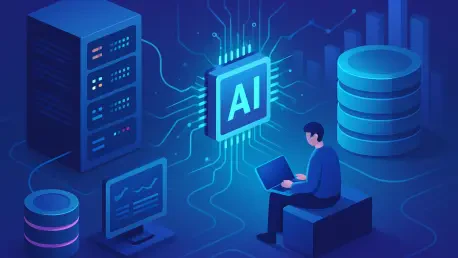In 2025, the artificial intelligence (AI) sector is experiencing explosive growth, with global investments in AI technologies projected to surpass hundreds of billions annually, yet a critical challenge looms large: data infrastructure inefficiencies. As AI workloads demand unprecedented volumes of data to be processed at lightning speeds, traditional storage and networking systems are buckling under the pressure, causing delays and stifling innovation. The Storage Networking Industry Association (SNIA) has stepped into this arena with Storage.AI, a groundbreaking open standards initiative designed to tackle these bottlenecks head-on. Backed by industry titans such as AMD, Cisco, Dell, IBM, and Intel, this effort aims to redefine how data is managed for AI applications. This market analysis delves into the trends, challenges, and future projections surrounding AI data infrastructure, exploring how Storage.AI positions itself as a catalyst for transformation in a rapidly evolving landscape.
Deep Dive into Market Trends and Data Dynamics
AI Workload Surge: A Strain on Legacy Systems
The AI market’s expansion has unleashed a torrent of data demands that legacy storage architectures are ill-equipped to handle. Unlike traditional workloads with predictable access patterns, AI processes—spanning data ingestion, preprocessing, training, and inference—require diverse data structures and massive bandwidth. Industry reports indicate that the volume of data processed for AI training models has grown exponentially over recent years, often doubling every 18 months. This surge exposes critical flaws in systems designed for linear tasks, where data must navigate multiple detours across disjointed networks, inflating latency and costs. Storage.AI emerges as a response to this mismatch, aiming to streamline data pipelines with vendor-neutral standards that can adapt to the chaotic nature of AI demands, potentially reshaping market expectations for infrastructure performance.
Hardware Disparities: The CPU-GPU Bottleneck Impact
A pivotal trend disrupting AI efficiency is the glaring disparity between CPU and GPU capabilities in data handling, a bottleneck affecting a significant portion of the market. GPUs, with thousands of cores optimized for parallel processing, drive AI computations but remain dependent on CPUs—with far fewer cores—to mediate storage requests. This imbalance, where a CPU might have only a fraction of the cores needed to feed a GPU, slows down data delivery and slashes throughput. Market analysis suggests that up to 40% of AI workload delays stem from such hardware mismatches. Storage.AI targets this issue with standards like GPU Direct Access, enabling direct storage-to-GPU transfers, which could unlock billions in efficiency gains for enterprises heavily invested in AI hardware.
Network-Storage Divide: Undermining High-Speed Investments
Another market dynamic is the disconnect between cutting-edge networking advancements and lagging storage systems, a gap that diminishes returns on infrastructure investments. High-performance fabrics like Ultra Ethernet have revolutionized data transfer speeds for AI workloads, yet these gains are often lost when storage remains a choke point at the pipeline’s end. Industry insights reveal that companies adopting advanced networking without corresponding storage upgrades see diminished performance benefits, sometimes by as much as 30%. Storage.AI’s integration of protocols such as File and Object over RDMA seeks to bridge this divide, aligning storage with network capabilities. This trend toward cohesive infrastructure could redefine competitive advantages for tech vendors and end-users alike in the AI space.
Diverse AI Phases: A Call for Customized Solutions
The multifaceted nature of AI workloads presents a unique market challenge, as each phase—from data preprocessing to archiving—demands tailored data handling not supported by one-size-fits-all systems. Current architectures often route data through inefficient paths, consuming excessive bandwidth and driving up operational costs, a concern for over 60% of AI-focused enterprises surveyed in recent studies. Storage.AI introduces frameworks like Compute-near-storage to minimize data movement by processing closer to storage repositories, addressing bandwidth-intensive tasks directly. This shift toward customized data solutions signals a broader market evolution, where flexibility in infrastructure design becomes a key differentiator for organizations aiming to scale AI operations efficiently.
Future Projections: Mapping the AI Infrastructure Landscape
Emerging Standards and Adoption Rates
Looking ahead, the trajectory of AI data infrastructure points to rapid adoption of open standards as a market driver, with Storage.AI poised to lead this charge. Analysts project that by 2027, over half of AI-driven enterprises will integrate standards like SDXI and GPU-Initiated I/O, spurred by the need for interoperable, scalable solutions. The modular approach of Storage.AI, allowing incremental adoption of components, mitigates the risk of implementation delays that plagued past storage initiatives. This flexibility could accelerate market penetration, especially among mid-sized firms seeking cost-effective upgrades, potentially shifting the competitive balance toward vendors aligned with open standards over proprietary ecosystems.
Economic and Regulatory Influences
Economic pressures to maximize hardware ROI are expected to further catalyze market shifts, alongside emerging regulatory frameworks around AI data privacy. With AI infrastructure costs soaring, businesses are prioritizing efficiency, likely driving demand for Storage.AI’s direct data access protocols that reduce resource waste. Simultaneously, stricter data handling regulations in key markets may push for secure, standardized storage solutions, positioning initiatives like Storage.AI as compliance enablers. Forecasts suggest a 25% uptick in demand for such standards-compliant systems by 2026, as companies navigate the dual challenges of cost and governance, reshaping procurement strategies across the tech sector.
Scalability for Next-Gen AI Models
As AI models grow in complexity, requiring ever-larger datasets and computational power, the market will demand infrastructure capable of preempting future bottlenecks. Storage.AI’s focus on scalable architectures, such as NVM programming models, addresses this need by ensuring storage keeps pace with compute advancements. Industry projections indicate that by the end of this decade, AI model sizes could increase tenfold, necessitating a radical overhaul of data pipelines. The initiative’s forward-thinking standards may become a cornerstone for next-generation systems, influencing market leaders to prioritize long-term interoperability over short-term proprietary gains, setting a new benchmark for innovation.
Reflecting on Insights and Strategic Pathways
In retrospect, the market analysis of AI data infrastructure challenges revealed a landscape fraught with inefficiencies, from CPU-GPU bottlenecks to network-storage misalignments, that hindered the potential of AI technologies. Storage.AI stood out as a transformative force, offering open standards to address these pain points with pragmatic, modular solutions. For businesses, the path forward involved strategic investments in compatible hardware and high-performance fabrics to align with emerging protocols. IT leaders were encouraged to train teams on these standards, ensuring readiness for rapid deployment. Additionally, forging partnerships with vendors committed to interoperability offered a competitive edge. As the AI sector continued to evolve, staying ahead of infrastructure demands through initiatives like Storage.AI proved essential for sustained growth and innovation.









